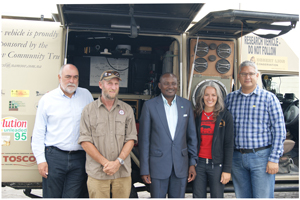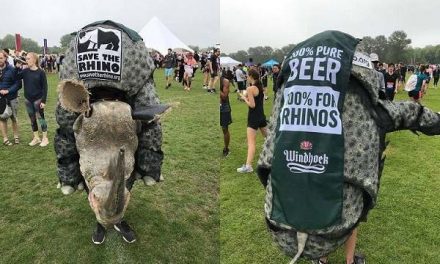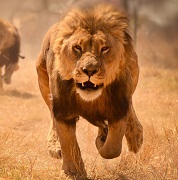
Fish boost lions and rhinos

At the donor presentation ceremony this week in Walvis Bay are from left to right, Mr Jan Arnold, MD of Bidfish Namibia, Dr Flip Stander, Desert Lion Conservation Project, Hon Pohamba Shifeta, Deputy Minister of Environment and Tourism, Ms Marcia Fargnoli, CEO of Save the Rhino Trust and Mr Jerome Mouton, CEO of Namsov Group of Companies.
Dr Stander, together with Ms Marcia Fargnoli of Save the Rhino Trust (SRT), attended a donor function in Walvis Bay earlier this week hosted by the Namsov Group of Companies, each to receive a Land Cruiser fieldcar for his and her respective conservation organisations. The event was attended by Hon. Pohamba Shifeta, Deputy Minister of Environment and Tourism, as well as by Namsov management and Namsov Community Trust Trustees.
Late last year Namsov Fishing undertook to replace the old primary field vehicles of both the Desert Lion Project and SRT. Two new Land Cruiser bakkies were purchased in late 2013, and modified to support the work of the field staff. The Cruiser for the Desert Lion Project had to be modified extensively to enable Dr Stander to use his sophisticated satellite tracking systems in the field. Namsov also agreed to make additional funds available for training of local communities to manage wildlife human conflict, and to teach younger people the need for conservation and the benefits to community tourism derived from wild lions.
Assisting Dr Stander to improve his surveillance, Namsov bought five satellite collars, and helped pay for the data cost of monitoring the collar-bearing lions. In total, the sponsorship to the Desert Lion Project came to just over N$600,000.
Dr Stander said human-lion conflict is arguably the biggest threat to lions in Africa. “There is need for proactive management of human-lion conflict to ensure the long-term conservation of the species. The Desert Lion Conservation project was started in 1998 to collect sound ecological data, address human-lion conflict and to develop a conservation strategy. Applied research and sound scientific data on lion movements and dispersal, and the ecological mechanisms that regulate the population are fundamental to this process. Lions are fitted with radio collars and are tracked and observed to record behaviour, movements, grouping patterns, reproduction and mortality. Lions are tracked using GPS and satellite technology.
Saving rhinos
Save the Rhino Trust received a Land Cruiser worth N$370,000 with a small amount for vehicle branding, registration and insurance. Namsov;s Tuna Willem of Namsov said the two donations brought their total Environment Spend to just over N$930,000.
Save the Rhino Trust was formed in 1982 to halt the slaughter of black rhino in the former Damaraland and Kaokoveld areas. Today these areas are part of the arid Kunene Region, home of the only wild, free-ranging black rhino population in the world.
Initially, a combination of ex-poachers and members of the local community were employed to monitor and protect the rhino. These men had extensive knowledge of the habits of these animals and the rugged terrain they inhabited. The aim of preventing the extermination of the endangered black rhino on communal land has been enthusiastically supported by Chiefs, headmen and the local communities. Since the Trust was formed, there has been close collaboration with the government, the local communities, and both national and international partners. This coalition has been central in achieving the aim of enhancing security for the rhino, monitoring and researching the rhino population, and providing benefit to the community through conservation and tourism. SRT has an administrative office in Swakopmund, and field bases at the Ugab River, Wereldsend, Mai Go Ha (Palmwag) and Mbakondja.











































